I had no idea that I was wrong.
Planing or Hydroplaning: Typically the term, planing, is preferred by boaters, while, hydroplaning, is preferred by drivers of land vehicles who encounter water on a road.
As recently as last week, I suggested that a surface-swimming animal lacked the muscle power to make the transition from displacement mode to planing mode. Yet, on Sunday, I watched Common Mergansers planing. Granted, they only maintained it for about four seconds — but they did do it.
An object (animal or boat) floating on water is in displacement mode: it displaces water such that its weight is supported by buoyancy. If it begins to travel across the surface, a bit of its weight may begin to be supported by the movement of the water against it, but displacement remains the primary support. However, if the object moves quickly enough, its weight can be primarily supported by the flow of water against its surface. It is now said to be planing. (It is analogous to an airplane being supported by the flow of air against the underside of the wings.)
Planing allows much greater speeds across a water surface than does displacement. (The fastest boats are those that can plane.) It seems reasonable that if a swimming animal wanted to move quickly, it too should plane. However, it takes considerable power to break out of displacement mode for it has an effective speed limit. I say, effective, because there is an energy barrier which takes considerable power to breach. (In like manner, an aircraft travelling faster than the speed of sound did not encounter an absolute barrier, but rather an energy barrier that had to be overcome.)
The issue of the effective speed limit during displacement mode was discussed in the posting, muskrat hull speed, and then further explored in ogopogo insights. The problem is that an animal swimming along the surface of the water makes a bow wave that moves at the speed of the swimmer. The faster the animal swims, the longer the wave. When the animal tries to swim so fast that the wavelength becomes twice its body length (hull length), an animal finds itself continuously swimming uphill from wave trough to crest. This requires considerable power, something that strains the musculature of most animals.
This problem is familiar to boaters, whether they be in a kayak, sailboat, or power boat. It takes considerable power to climb the bow wave so as to make the transition from displacement to planing. The power required to make the transition increases with the weight (and thus also the number of passengers) of the boat attempting the feat. A way to express this is that the ability to move from displacement to planing depends upon the ratio of power to weight — the larger the ratio, the easier it is.
The interesting thing is that if this power is supplied by muscles, the smaller the animal, the greater the ratio of power to weight. This is because with decreasing size, weight decreases faster than strength. So, smaller animals might be able to accomplish what larger ones cannot. But, how small is small enough? Based on Sunday’s observation, an adult Common Merganser makes the cut.
Some mergansers were foraging with their heads tipped down as they looked for fish. They are in displacement mode as is evident by bow waves at the front of their heads. They are travelling at about their hull-speed limit.
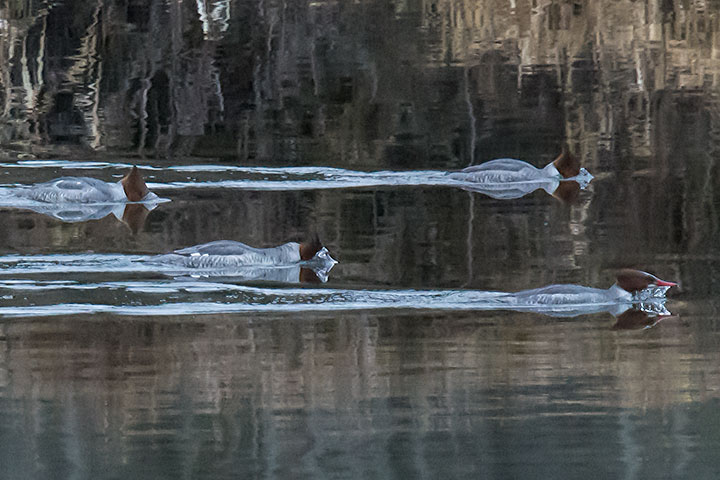
When a lead merganser spotted a fish and dived for it, another merganser then tried to steal the catch. Excited by the kerfuffle, two others accelerated and began planing. This is evident by the lack of a bow wave and the nature of the wake. They accomplished this without the use of their wings.
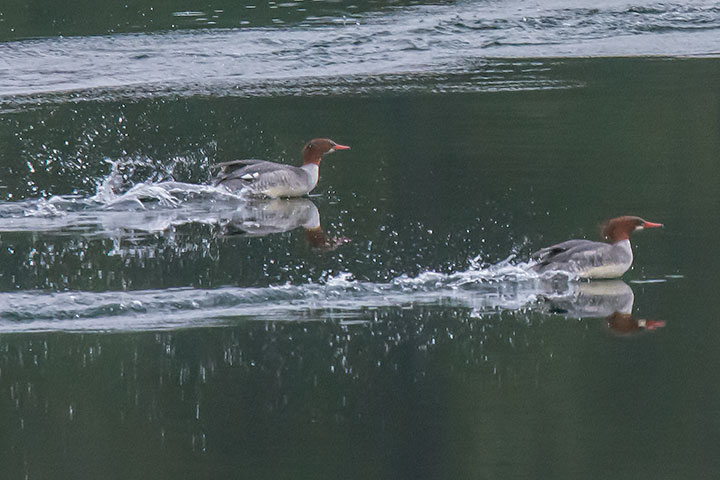
Meanwhile the merganser with the fish (dangling from its bill) also began planing but did so using both its feet and wings. The chasing merganser planed briefly, but is now giving up and dropping back to displacement mode.
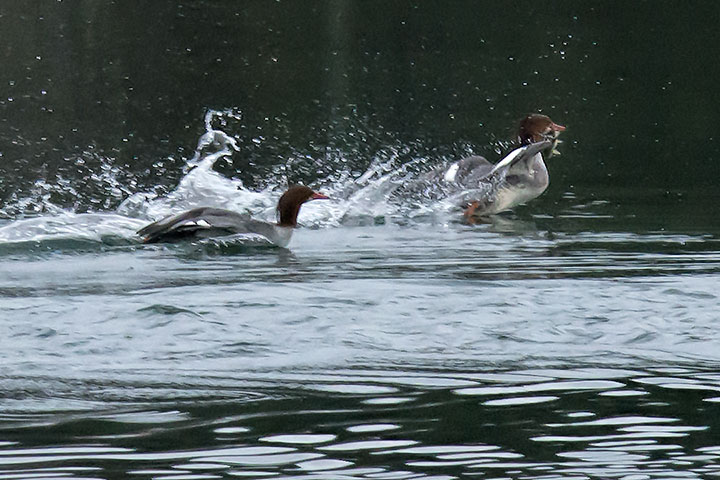
That other swimming birds have been seen to do this is clear from the paper Hydroplaning by [mallard] ducklings, published in 1995. This is consistent with my realization that making this transition should be easier for the smallest swimming animals.
Buoyed by this, I looked through all my mallard pictures, but found none showing ducklings planing. Next, I searched through old pictures of merganser chicks and found a couple showing planing merganser chicks, the significance of which had initially gone unappreciated.
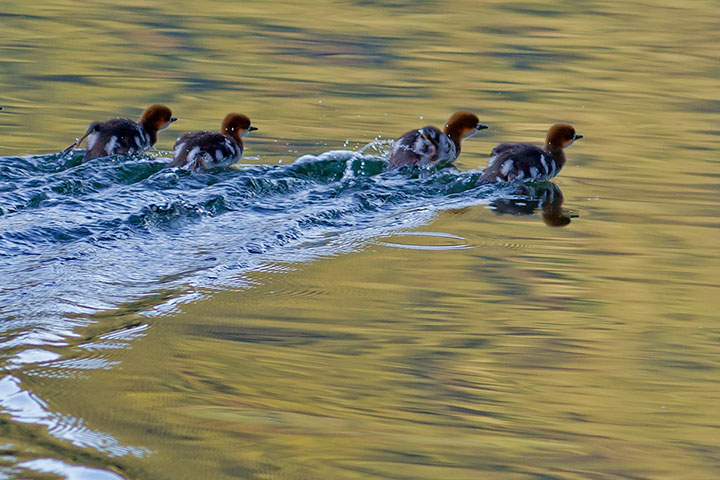
I even found an earlier shot of adult mergansers planing in my posting, merganser’s warning.
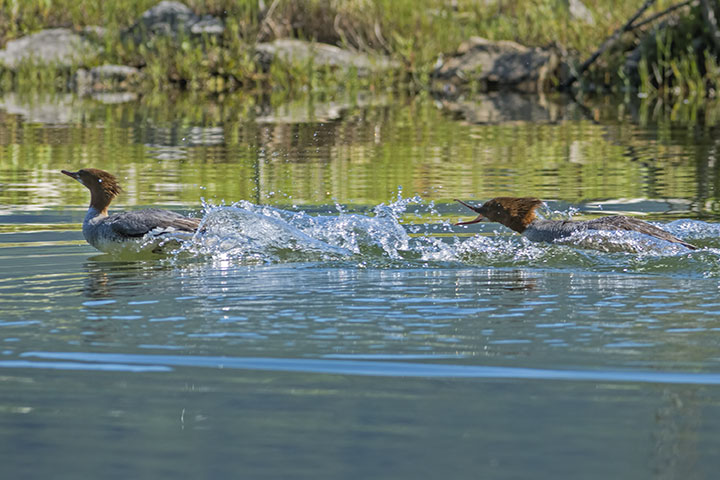
A 2013 paper told of a Common Eider planing. This bird is over a third heavier than the Common Merganser, and it needed help from its wings. It may be that our merganser is about the heaviest bird to be able to plane using propulsion by its feet alone.
Now, what about the muskrat, our Lake’s smallest aquatic mammal? It has about the same average weight as the Common Merganser. I have neither seen nor heard reports that it can exceed its hull speed. I speculate that it lacks the power to plane. The muskrat is (substantially) a vegetarian and will have had little pressure to develop the burst of speed of a predator such as a merganser. The two may have comparable weight, but they lack comparable necessity. Similarly, although a Mallard is smaller than a Common Merganser, it lacks the need for planing speeds when hunting plant material. Certainly, I haven’t seen one plane. Here is a muskrat travelling at about its hull speed, which seems to be the best it can do.
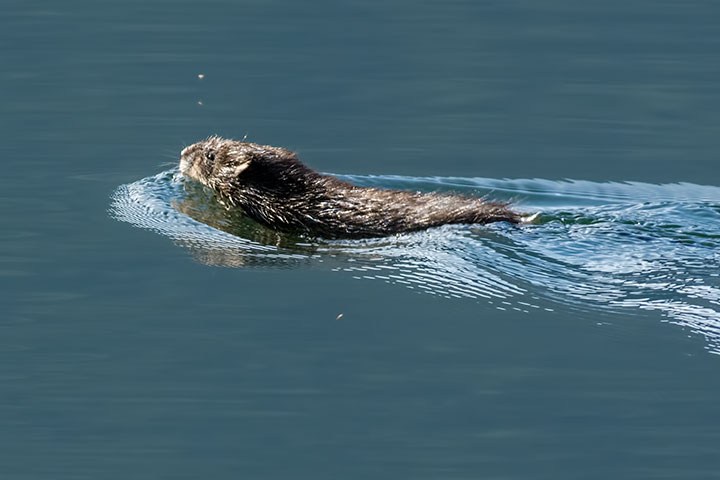
This exploration was inspired by asking about an otter’s occasional need to exceed its hull-speed limit. The otter’s workaround is to swim underwater, a tactic discussed in ogopogo insights. It seems that otters are much too heavy to be capable of planing. Yet, it was enormously good fun to discover that some smaller animals (birds, actually) can do this.
Finally, I note that I have long known that a bird landing on water has the initial speed to plane, as illustrated by the planing dipper, below. However, the issue here has been whether an animal swimming in displacement mode has the power to start planing. It seems that a Common Merganser has, but neither a muskrat nor otter does.
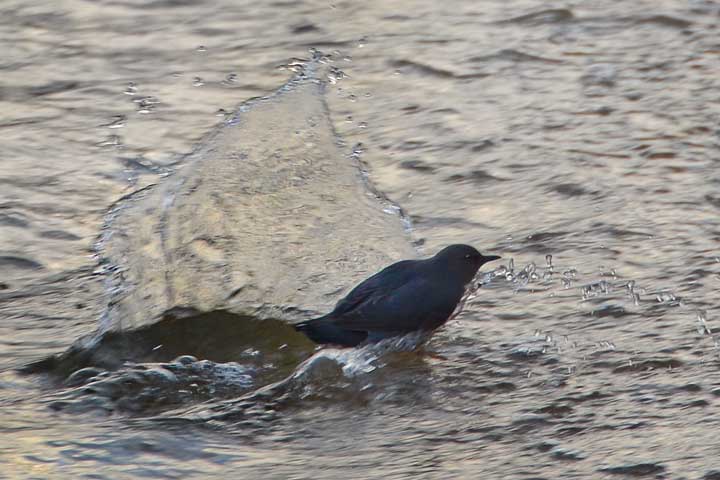

Very well explored and explained, Alistair!
The first photo looks like a Robert Bateman painting…and that is a compliment to both of you.
The overall colour and composition of the four little guys is amazing. You are amazing.
Hi Alistair
Seldom have I found a lesson in physics more engaging!
Like some of your earlier posts, this one feels to me like the early makings of a book – one that might actually persuade some of us to really look and ponder. Such a book would be a much needed kickstart for a new genration of naturalists!
Trevor: I, too, have made that suggestion to Alistair; He wasn’t amenable at that time. I keep a scribbler of gleanings from the posts for my own education.
I thoroughly enjoyed this article. The mergansers are indeed common on our lake, I have watched them fish, dive, rear young, and now this gives me something else to watch for.
A float plane when taking off initially accelerates to hull speed, then lifts and planes on the water surface until it gains enough speed for flight. We don’t see that with water birds taking off as they use the wing motion and feet to get their bodies out of the water. But when landing we see the planing and hull speed transition. A float plane will touch down, plane along the surface until it decelerates to hull speed. More than one inattentive pilot has found themselves nose down in the water as the increased drag slowed the floats more than the aircraft sitting above.
Mallards landing will initially put their feet down on the water surface, then their body and as the drag of hull speed increases stretch their neck out both to reduce the drag and maintain their dignity by not ending tail up with their head under water. That position is reserved for feeding.